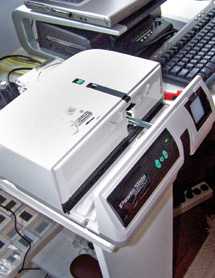Pacific Image Electronics’ PowerSlide 3600
This one is for everyone who is making the transition from film to digital and has file drawers filled with 35mm slides. It's also for teachers, clubs, and institutions who might want to convert 35mm slides to digital files for lectures, presentations, and archiving. Indeed, the Pacific Image Electronics PowerSlide 3600 is one of the most practical and easy-to-use tools that we've worked with in a while, especially for the often daunting task of converting lots of slides to digital image files. Yes, we've worked with excellent 35mm slide scanners and dedicated flat-beds, and these produce great results, but too often the slide count is limited to six at a time, which makes handling bunches of slides a less than easy task. Even 12-at-a-time flat-beds pale next to the productivity of the 3600. In the configuration we used we could load 50 slides at a shot, turn on Multi-Scan and walk away, with all 50 scans made in a little under an hour's time.
 |
This PC and Mac compatible scanner looks all the world like an old push-pull
slide projector (for old-timers, the Braun and reflecta models are most akin)
with a scanning system where the bulb and lens setup once sat. You load slides
into a 50-slide flat tray or even more in a rotary tray, which we did not test,
and the unit moves the slides through one at a time. To get started you load
the scanner software, which is recognized by the supplied Adobe Photoshop Elements
2.0 software, although we used Elements 3.0 with no problem. All you need do
is start Photoshop and go to Image>Import and choose the CyberView
X-MS option, the software for the scanner. You then choose the scanning parameters
and Multi-Scan, then choose how many slides you want in the set (and that you
have loaded) and off the unit goes.
You can set up the scanning parameters and even pre-scan to set up color balance,
curve adjustments, and so forth. But this only works if all the slides in the
set you are multi-scanning have similar characteristics. We let all go to default
to speed the process and make the most efficient use of the unit. The only thing
we did set up is the scanning resolution, which you should choose according
to your scanning needs. We set up for presentations for the most part, as our
task was to convert film slide shows to PowerPoint shows for teaching. You can
get up to 94MB (16-bit depth) files if need be, but obviously that's vast
overkill for the project we had in mind.
 |
|
|
The first step is setting the scan resolution in dpi, from 1200 at 8 bit,
which yields about a 5MB file, to 3600dpi at 16 bit, which yields the aforementioned
94MB file, both in TIFF. A pop-up window, called the Active Frame Setting, allows
you to do this without going into the menu. If you want to go into the accompanying
CyberView X software you can identify the folder you want to create to receive
the scans, the format and level of compression (if JPEG is selected), and the
resolution. There's also some Variations and other image settings available,
if you want to pre-scan and work each slide individually. If JPEG format is
selected the "Best" setting compresses the file on about a 10:1
ratio. While you can scan to a folder or file, we went right into Elements for
immediate image fixes and then saves.
In all, the unit operated flawlessly. The only time it did jam was when we failed
to clear an old stick-on label that was loose on the slide and got into the
mechanism. A handy slide retriever allows you to clear such bothersome problems.
While the unit will try to clear the problem itself by moving the push-pull
mechanism in and out a few times it stopped so that the slide did not get mashed
in the process and sat patiently waiting for us to clear it. Once we did we
did not lose the previous scans and could just instruct the scanner to go on
from there to finish up the tray. Once scanned the slides sit in a line-up in
Elements as TIFFs (our preference), and it was quick work to save them to a
folder for later editing, sorting, and clearing of any dust we failed to clean
while loading.
Priced at about $749, the Pacific Image Electronics PowerSlide 3600 is both
USB 2.0 and FireWire compatible. At that price it's a great value for
those who need to scan lots of 35mm slides quickly and efficiently. It can make
weeks of work doable in just a couple of days, and is the perfect "rainy
day" way to convert tons of slides to digital files quickly, easily, and
efficiently. We recommend it as a very good buy for anyone who wants to make
those conversions from lots of slides, and especially for schools, clubs, teachers,
and historical societies who are eager to get their images ready for the web.
For more information, contact Pacific Image Electronics, 1830 W 208th St., Torrance,
CA 90501; (310) 618-8100; www.scanace.com.
- Log in or register to post comments

































